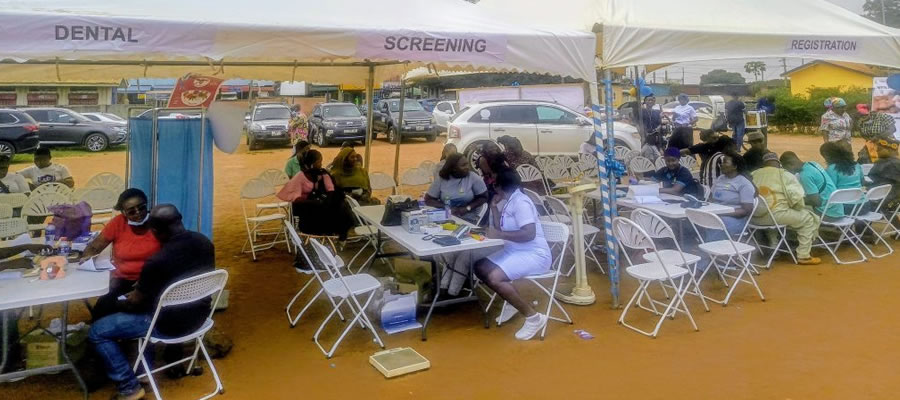

Introduction
It is important that the size, composition and distribution of any population be analyzed to facilitate development planning and implementation of policies. A country’s population composition greatly influences its needs and well-being. The current decentralized governance system and administration of planning in Ghana require that statistics are provided on the size, composition and distribution of the population at the Metropolitan, Municipal and District levels. This chapter analyses population size and distribution, age-sex structure, nationality, fertility, mortality and migration in the La Nkwantanang Madina Municipality.
Population Size and Distribution
Table 2.1 presents the population of the La Nkwantanang Madina Municipality by age, sex, sex ratio and type of locality. The total population of the Municipality in 2010 was 111,926 comprising 48.5 percent males as against 51.5 females, giving a sex ratio of 94.1 percent compared with 93.6 in the region and 95.2 at the national level (GSS, 2012).
In terms of age distribution, the greatest proportion of the population (13.0%) was in the age bracket of 20-24 while the least proportion of 0.0 percent fell within the age category of 95-99 (Table 2.1).
The results also showed that the proportion of the population among age groups starting from 20-24 years generally decreases in each subsequent age group. The highest proportion of the male and female population was also within the age category of 20-24. The La Nkwantanang Madina Municipality is generally urban with 84 percent of the population resident in urban areas, particularly those aged between 75-79 years. It has a total dependency ratio of 47.2, which was lower than that of the region with 53.4. Total dependency ratio was higher in rural (52.7) than urban areas (46.2).
Age-Sex Structure
The population pyramid (Figure 2.1) presents the age-sex structure of La Nkwantanang Madina Municipality in 2010. The age structure shows a youthful population, which is characteristic of most developing countries. The bulge of the population at age groups 20-24 years and 25-29 years could be attributed to the influx of migrants into the Municipality, perhaps for employment purposes. In general, there are more females than males in all the age groups which conform to other districts in the region. This is consistent with the fact that females constituted more than half of the total population of Ghana (GSS, 2012).
Figure 2.1: Population Pyramid
Fertility, Mortality and Migration
Introduction
This section deals with the analysis of three components of population dynamics namely fertility, mortality and migration in the various districts in Greater Accra Region using the 2010 PHC data. The section on fertility looks at age- specific fertility, general fertility, total fertility and crude birth rate by district while the section on mortality considers deaths in households 12 months preceding the census night and crude death rates. The final section presents information on migration. 19
Fertility
Information on fertility is key in analyzing the growth of a country’s population. Some definitions on fertility were proposed in the 2010 census. Lifetime fertility was defined as the total number of live births that females 12 years and older had ever had during their life time while current fertility refers to the number of live births that females 12-54 years and old had in the 12 months preceding the Census Night.
Total Fertility Rate (TFR) was defined as the total number of births a woman would have by the end of her childbearing period if she were to pass through those years bearing children at the currently observed age-specific fertility rates. General Fertility Rate (GFR) was given as the number of live births occurring during a specified period per 1,000 women aged between 15-49 while, Crude Birth Rate (CBR) was defined as the number of births per 1,000 population during a specified period. Women were asked some questions to determine the total number of live births they had in their lifetime, children surviving and births in the past 12 months. Data collected included that of females 12-14 years, which is below the recommended age-specific fertility range of 15-19 years usually used in computing adolescent fertility.
Table 2.2 has shown that the total fertility rate for the La Nkwantanang Madina Municipality was 2.5, which was slightly lower than the regional average of 2.6 and the National average of 3.3. Also, both the GFR and CBR of the Municipality (GFR= 71.7 and CBR=22.5) were lower than that of the region (GFR=75.7 and CBR=22.7). The low levels of TFR, GFR and CBR in the La Nkwantanang Madina Municipality compared to the regional averages could be due to the use of contraceptives among females to prevent pregnancy, out-migration of males or increase in male mortality (Table 2.2).
Migration
Migration may be defined as a spatial movement involving a temporary or permanent change in one’s usual place of residence from one geographical area to the other within a specified period of time (Tanle, 2010). In this section, migration is measured with respect to birthplace and duration of residence as shown in Table 2.4
Results in Table 2.3 revealed that out of the total population of 111,926 in the Municipality, 65.7 percent (73,545) are migrants (born either elsewhere in the Greater Accra Region or other regions in Ghana or outside Ghana).
It is observed that persons born outside the Greater Accra region but resident in the Municipality were mostly from the Eastern Region (30.0percent) (17,651) while those from the Upper West region were the least (1.4percent) (818). Table 2.4 also indicates that 15.4 percent of migrants had resided in the Municipality for less than one year, 30.7 percent had stayed between 1-4 years while 14.8 percent had stayed over 20 years. The high proportion of migrants in the Municipality could be due to the fact that the La Nkwantang Madina Municipality was a cosmopolitan Municipality, which attracted migrants from all over the country to the city in search of jobs and other economic opportunities (Table 2.4).
Figure 2.2 shows reported age-specific death rates by sex. Age-specific death rates were the same for both sexes from age 0-29 years but mortality was higher among females than males from age group 30-49 years. The high mortality rate among females in that age group could be attributed to maternal mortality since those ages fall within the reproductive period among females. However, higher proportions of deaths were recorded among males than females after age 49 years. This is expected because in Ghana males generally have a lower life expectancy than females due to the nature of the work that they do which usually expose them to the risk of dying earlier than females as age increased (Vallin, 2007).
Date Created : 12/5/2017 3:15:12 AM









 facebook
facebook
 twitter
twitter
 Youtube
Youtube
 +233 593 831 280
+233 593 831 280 0800 430 430
0800 430 430 GPS: GE-231-4383
GPS: GE-231-4383 info@ghanadistricts.com
info@ghanadistricts.com Box GP1044, Accra, Ghana
Box GP1044, Accra, Ghana